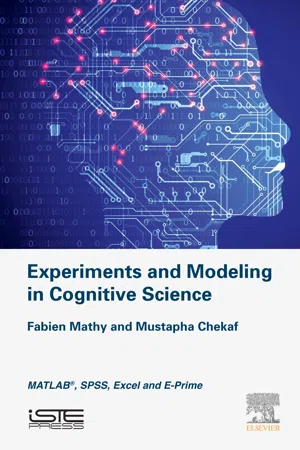
Experiments and Modeling in Cognitive Science
MATLAB, SPSS, Excel and E-Prime
- 302 pages
- English
- ePUB (mobile friendly)
- Available on iOS & Android
Experiments and Modeling in Cognitive Science
MATLAB, SPSS, Excel and E-Prime
About This Book
Software Simulation and Modeling in Psychology: MATLAB, SPSS, Excel and E-Prime describes all the stages of psychology experimentation, from the manipulation of factors, to statistical analysis, data modeling, and automated stimuli creation. The book shows how software can help automate various stages of the experiment for which operations may quickly become repetitive. For example, it shows how to compile data files (instead of opening files one by one to copy and paste), generate stimuli (instead of drawing one by one in a drawing software), and transform and recode tables of data.
This type of modeling in psychology helps determine if a model fits the data, and also demonstrates that the algorithmic is not only useful, but essential for modeling data.
- Covers the entire process of experimenting, from designing an experiment, to modeling the data
- Shows how software can help automate various stages of the experiment for which operations may quickly become repetitive
- Contains sections on how to compile data files (instead of opening files one by one to copy and paste) and generate stimuli (instead of drawing one by one in a drawing software)
Frequently asked questions
Information
Principles of Modeling*
Abstract
Keywords
1.1 Experiments, models and simulations
Table of contents
- Cover image
- Title page
- Table of Contents
- Copyright
- Preface
- Part 1: Experiments, Models, Simulations
- Part 2: Experimentation
- Part 3: Analysis and Modeling
- References
- Index